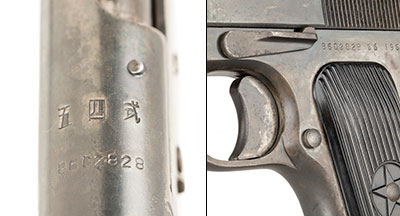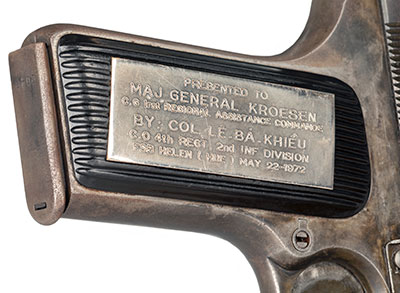
Fedor Vasilievich Tokarev was one of Russia’s foremost arms designers during the 20th century. At the age of 17 he began his studies as a gunsmith, eventually graduated college and was made an officer in a Cossack regiment. In 1907 he converted a Mosin-Nagant M1891 rifle to a semi-automatic, thus beginning a lifelong career in arms design. After surviving the Great War, he continued to work at the Izhevsk Arms plant and at one time was under sentence of death from the Bolsheviks. Needing their arms factories to function for their fledgling Red Army, the sentence was lifted, and he went to the Tula Arms factory to streamline production and to work on his designs.
The standard sidearm of the Russian military since 1895 was the M1895 Nagant revolver in 7.62x38 mm R. While the world quickly adopted semi-automatic pistols for their armed forces, Russia focused on mass production of the Nagant until 1930, when a commission was formed to select a new semi-automatic pistol.

Tokarev used some design elements from John M. Browning’s 1903 and 1911 pistols, specifically the blowback action and the tilting-barrel action, respectively. The Russians adopted Tokarev’s design the same year, and it was named the TT30 for Tula (Factory) Tokarev (designed) Model of 1930.
As is the case with most manufactured goods, it takes a year or two to iron out the flaws in functioning and manufacture. Tokarev designed a new and improved version of the pistol in 1933 and it became the TT33, the most produced pistol of the Communist bloc in the 20th century with nearly (or as near as we can figure, based on still-classified manufacturing records) 2 million manufactured from 1933 to the present (it’s thought that some variants are still being made in the “hermit kingdom” of North Korea and by the Chinese Norinco factory).
The TT33 fires a powerful, bottlenecked 7.62x25 mm cartridge based partly on the 7.63x25 mm of the Mauser C96 broomhandle pistol. Known commonly as the 7.62 Tokarev, the round packs a decent punch and the pistol employs an eight-round magazine. The TT33 became the standard sidearm of the Soviet military throughout World War II, with more than 1.3 million produced for that conflict alone. Captured TT33s were also employed by the German Army during the war and designated the 615r pistol, although these guns were never marked as such. The Finnish Army captured a number of TT33s, and they are marked with the Finnish “SA” stamp on the frames.

Following the war, TT33 copies were made in Poland, Hungry, Romania and Yugoslavia, and used extensively by their armed forces for the latter half of the 20th century.
The Russian manufacture of the TT33 ended in 1955, but that would not be the end of the story of the TT33. The Chinese picked up the manufacturing of the gun initially in 1951, at first using mostly Russian-made parts. By 1954, the entire pistol was made in Chinese factories. The Chinese version was known as the “black star” pistol because the gun kept the Russian-designed grips with the black star, but without the letters CCCP (Union of Soviet Socialist Republics) inside each point of the star. Officially it was designated the Type 54, although it was not produced for use until 1955. The Chinese Type 54 was supplied to the North Vietnamese during the Vietnam war, and many were souvenired by returning G.I.s.
The 1968 Gun Control Act changed the market for TT33s, as the pistol was initially manufactured without any type of safety, making it ineligible for import. Thousands were converted post-manufacture with a safety catch, making those without a safety quite collectable. Most TT33s and Type 54s are marked with the year of manufacture on the left side of the frame.
As with most firearms of such widespread use and stature, there is an endless variety of them out there: .22 LR models, 9x18 Makarov versions and a hopeless variety of holsters and accoutrements, including field manuals available in many languages, for the collector to chase.




































